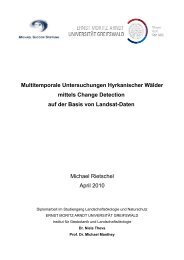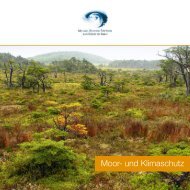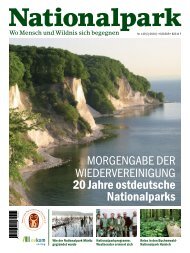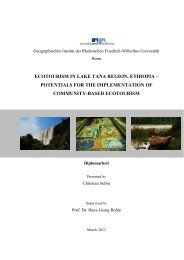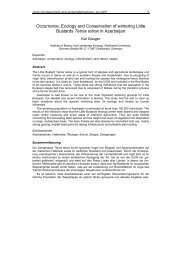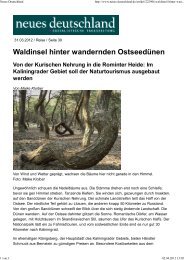Ecology and regeneration of forest communities on the alluvial fan ...
Ecology and regeneration of forest communities on the alluvial fan ...
Ecology and regeneration of forest communities on the alluvial fan ...
Create successful ePaper yourself
Turn your PDF publications into a flip-book with our unique Google optimized e-Paper software.
-Discussi<strong>on</strong>-<br />
N<br />
E<br />
S<br />
W<br />
6 0 0 m<br />
4 0 0 m<br />
S l o p e<br />
2 0 0 m<br />
V a l l e y F l o o r<br />
1 0 k m<br />
S c l e r o p o a r i g i d a - P o p u s n i g r a<br />
c o m m u n i t y<br />
Q u e r c u s i b e r i c a - C a r p i n u s o r i e n t a l i s<br />
c o m m u n i t y<br />
E q u i s e t u m t e l m a t e i a - A l n u s b a r b a t a<br />
c o m m u n i t y<br />
S w i d a s a n g u i n e a - P o p u l u s a l b a<br />
c o m m u n i t y<br />
C o t i n u s c o g g y g r i a s h r u b l a n d Q u e r c u s r o b u r - C a r p i n u s b e t u l u s<br />
c o m m u n i t y<br />
F r a x i n u s e x c e l s i o r - P t e r o c a r y a p t e r o c a r p a<br />
c o m m u n i t y<br />
O p l i s m e n u s u n d u l a t i f o l i u s - A c e r v e l u t i n u m<br />
c o m m u n i t y<br />
w a t e r f l o w r o c k s , s t o n e s g r a v e l , s a n d s i l t , c l a y<br />
Fig. 5.3 L<strong>on</strong>gitudial secti<strong>on</strong> <str<strong>on</strong>g>of</str<strong>on</strong>g> <strong>the</strong> <strong>fan</strong><br />
Direct effects <str<strong>on</strong>g>of</str<strong>on</strong>g> flooding include reduced oxygen exchange <str<strong>on</strong>g>and</str<strong>on</strong>g> hampered soil water<br />
movement (Hughes et al. 2001) uprooting (Karrenberg et al. 2003) as well as burial by<br />
sediments (Marigo et al. 2000). Indirect effects are <strong>the</strong> creati<strong>on</strong> <str<strong>on</strong>g>of</str<strong>on</strong>g> bare substrates due to<br />
sedimentati<strong>on</strong> (Johns<strong>on</strong> 2000), decreased vegetati<strong>on</strong> cover <str<strong>on</strong>g>and</str<strong>on</strong>g> increased nutrient supply<br />
(Thoms 2003). The resp<strong>on</strong>se to <strong>the</strong> above menti<strong>on</strong>ed factors varies am<strong>on</strong>g species. The<br />
s<str<strong>on</strong>g>of</str<strong>on</strong>g>twood species Salix spp. <str<strong>on</strong>g>and</str<strong>on</strong>g> Populus spp. tend to be better adapted to flooding than<br />
<strong>the</strong> hardwood broad leafed deciduous species Quercus spp, Ulmus spp. <str<strong>on</strong>g>and</str<strong>on</strong>g> Fraxinus<br />
spp. (Vreugdenhil et al. 2006). In Europe, this results in a typical z<strong>on</strong>ati<strong>on</strong> <str<strong>on</strong>g>of</str<strong>on</strong>g> <strong>the</strong><br />
s<str<strong>on</strong>g>of</str<strong>on</strong>g>twood species Salix spp. <str<strong>on</strong>g>and</str<strong>on</strong>g> Populus spp. near <strong>the</strong> main channel <str<strong>on</strong>g>and</str<strong>on</strong>g> <strong>the</strong> hardwood<br />
species Quercus spp., Ulmus spp. as well as Fraxinus spp. dominating <strong>the</strong> less<br />
frequently flooded sites (Ward et al. 2002; Ellenberg 1988). These observati<strong>on</strong>s could<br />
be affirmed within this study, though <strong>the</strong> s<str<strong>on</strong>g>of</str<strong>on</strong>g>twood z<strong>on</strong>e was <str<strong>on</strong>g>of</str<strong>on</strong>g>ten narrow <str<strong>on</strong>g>and</str<strong>on</strong>g><br />
sometimes completely lacking, possibly due to already reduced river dynamics. Both<br />
poplar species were obviously restricted to bare soils in, or adjacent to <strong>the</strong> open riverbed<br />
where flood dynamic is greatest. Populus nigra prefers <strong>the</strong> upper sites (Fig. 5.3 , Fig.<br />
5.4 <str<strong>on</strong>g>and</str<strong>on</strong>g> Fig. 5.6), obviously better adapted to survive drier periods in summer. Glenz et<br />
al. (2006) indicate its flooding tolerance with high (4) (Table 5.1).<br />
-<str<strong>on</strong>g>Ecology</str<strong>on</strong>g> <str<strong>on</strong>g>and</str<strong>on</strong>g> <str<strong>on</strong>g>regenerati<strong>on</strong></str<strong>on</strong>g> <str<strong>on</strong>g>of</str<strong>on</strong>g> <str<strong>on</strong>g>forest</str<strong>on</strong>g> <str<strong>on</strong>g>communities</str<strong>on</strong>g> <strong>on</strong> <strong>the</strong> <strong>alluvial</strong> <strong>fan</strong> near Qakh (Northwestern Azerbaijan)-<br />
39



